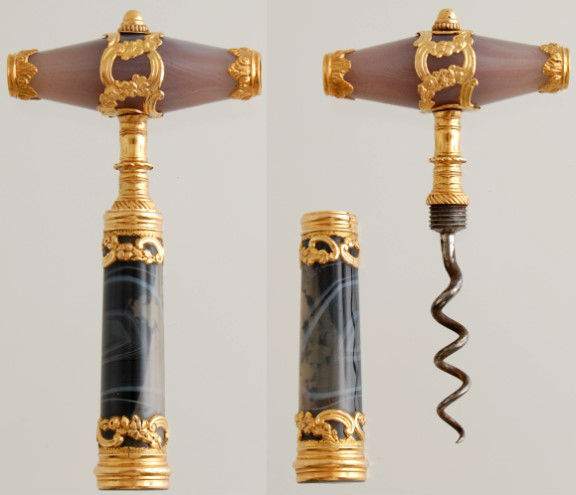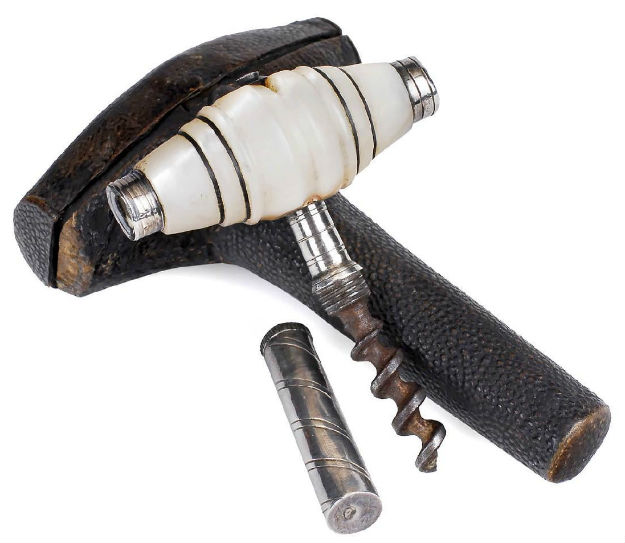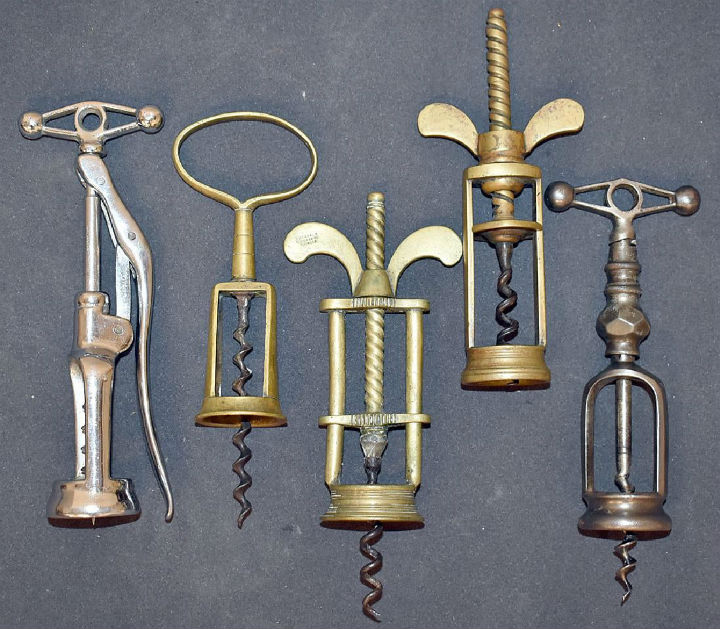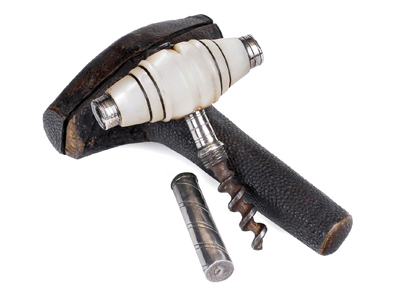
NEW YORK – The earliest corkscrew patents issued were for a simplistic yet effective T-shaped design, comprising a rod/spike attached to a bar/handle. Over the years, corkscrews and their handles became highly decorative, taking the form of everything from female nudes and ships to animals. Bar collectibles are big business with unusual and striking corkscrews chief among them.
“Corkscrews were made to open bottles of wine but also to open medicine bottles, perfume bottles and beer bottles,” said veteran corkscrew collector Barry Taylor, a manager and administrator at Corkscrewsonline.com.
“Corkscrew collectors often search for a broad range of pieces, including mechanical corkscrews, pocket corkscrews, figural corkscrews, and combination tools containing corkscrews and cork extractors. In general, the rarest and desirable pieces fall into three broad categories: (1) 18th century corkscrews, (2) 18th and 19th century silver pieces and (3) 19th century mechanicals.”

Early 18th century corkscrews are generally of particular interest to collectors. English and French origin examples are predominantly desirable. Taylor notes these are typically beautifully handcrafted pieces and usually quite difficult to find.
“Nineteenth century mechanicals, silver pieces and pocket corkscrews are avidly sought by collectors and are more readily available in major auctions, antique markets and from specialist dealers,” he said.
The heyday for vintage corkscrew production was the mid- to late-19th century – in the throes of the Industrial Revolution. “This made quality mass-produced pieces readily available for the first time. In general, these are the pieces many collectors are looking for,” Taylor added. “It is also important to note that this was a period when corkscrews were first patented. Early patents and registrations from this period and earlier are often very desirable. The late 19th century is also when patented American pieces first entered the market.”

Longtime collector Ian Hunter is the right of the International Correspondence of Corkscrew Addicts, (“right” is a term the ICCA uses instead of president in homage to Henry Clay who famously said he’d rather be right than president). In England, the home of collectible corkscrews was Birmingham as that’s where most great patents came from, most notably the first corkscrew patent (Henshall, 1795) and perhaps the most iconic mechanical (Thomason, 1802) and many others, Hunter said. “Sheffield was the center of English cutlery, lots of corkscrews were made there, but they were mainly simple T’s and corkscrews combined with knives. The nice English pieces mainly came from Birmingham.”
In the 18th century, the center of corkscrew innovation was Dublin where cutler craftsmen were making individual pieces by hand, he noted. “Then Birmingham took over with mass production as part of the Industrial Revolution. Henshall’s 1795 patent was actually based on an earlier corkscrew of Thomas Read in Dublin. You will see that Read’s “coaxer” has been the highest priced sale on CollectorCorkscrews.com at $35,000.” While 18th century Irish corkscrews are highly sought after, an English Osborne patent of 1839, which sold in an English auction house in 2014, is said to be the highest selling price of all time.

In the 19th century, there were three principal centers for corkscrew production: Sheffield in England, Solingen in Germany and Eskilstuna in Sweden, Taylor explained. “These were the principal knife-making centers at that time and it was a natural extension of their business to add corkscrews to pocket knives and then to produce individual corkscrew pieces.” At this time, the French and Italians were also making excellent high-quality corkscrews and 19th and early 20th century French corkscrews are very desirable, he added. In the late 19th century and early 20th century, American mechanicals and combination tools joined the market and many patented pieces from this era are of peak interest to collectors.
Sometimes a corkscrew is more than a corkscrew. Produced in thousands of different variations, corkscrews have been combined with a large range of other tools and implements. These can include can openers, bottle openers, knife sharpeners, pastry wheels, meat cleavers, carriage keys, match safes and cigar cutters. Combination tools of this type are definitely of interest to collectors, but are not inherently more valuable.

In general terms, there are three main factors to consider when purchasing a vintage corkscrew: rarity (only a very few known examples will usually command high prices), desirability (some specific types or pieces are more valuable with collectors because of a unique appearance or unusual features), and last but not least, its condition.
As new collectors learn more on this field and study articles and books on the subject, veteran collectors advise buyers to start with a focus (either geographic or by type of corkscrew) and joining one of the many corkscrew clubs around the world.
Taylor also said there is no substitute for firsthand inspection. “Look at pieces carefully and learn to assess the condition of a piece. Does it function correctly, does it operate smoothly, are parts worn or damaged, what is the overall condition of the piece, how much of the original finish or plating is still intact, does the piece have any chips or cracks? How does this piece compare to pictures or other pieces you have seen?” he said.
And aside from the usual caveat of buying from whom you know and buying what you know, buy a corkscrew that makes your heart race.


